Theme
In the final position of a H#2, the black King, standing on square 'x', is threatened from square 'y' by a line piece 'A' ('A'=Q,R,B). A double check on the mating move is not allowed. In the initial position, a black piece and a white piece (any pieces, including Pawns) are situated on the interval between squares 'x' and 'y', while the black King and the line piece 'A' are standing on squares that are different from 'x' and 'y' respectively (their final squares). Zeroposition settings are not allowed.
Example:
List of Participants
The director received 105 entries by 44 composers from 21 countries. 38 problems by 9 composers (20 of them by a single composer) were found non-thematic and/or unsound, and were returned to their authors. 9 of these came back as corrected versions. On 2 September 2002, 76 sound problems were submitted (anonymously) to the judge, Menachem Witztum, for evaluation. A number was assigned to each correct entry as follows:
Uri Avner (Israel) 1, 5, 5a, 10, 18; Anatolij Vasilenko (Ukraine) 2; Árpád Molnár (Hungary) 3, 4, 7, 8, 9, 75, 76; Yoel Aloni (Israel) 11; Jean Haymann (Israel) 12, 13, 14; Jozef Lozek (Slovakia) 15, 16 Michael Shapiro (Israel) 17, 29-32, 37, 53, 54, 58; Fadil Abdurahmanović (Bosnia & Herzegovina) 19; Ricardo de Mattos Vieira (Brazil) 20; Johan de Boer (Netherlands) 21; Viktor Syzonenko (Ukraine) 22-24; Mircea M. Manolescu (Romania) 25-28; Michal Dragoun (Czech Republic) 33-35; Michal Dragoun & Dieter Müller (Czech Republic & Germany) 36; Colin Sydenham (England) 38, 74; Leonid Lyubashevsky (Israel) 39; Leonid Lyubashevsky & Leonid Makaronez (Israel) 40; Vito Rallo & Roberto Cassano 41; L. Togookhuu (Mongolia) 42-44; Jozsef Pasztor (Hungary) 45-47; Miomir Nedeljković (Yugoslavia) 48, 49; Mario Parrinello (Italy) 50-52 Raffi Ruppin (Israel) 55; Alexander Semenenko (Germany) 56; Valerij Semenenko (Ukraine) 57; Jorge Humberto Brun (Argentina) 59; Henryk Grudzinski (Poland) 60; Strahinja Mihajlović (Yugoslavia) 61; Borislav Gadjanski (Yugoslavia) 62; Vito Rallo & Roberto Cassano (Italy) 63, 64; Kamlik Karapetyan (Armenia) 65; Manfred Rittirsch (Germany) 66; Ion Murarasu (Romania) 67; Christer Jonsson (Sweden) 68; Franz Pachl (Germany) 69, 70; Franz Pachl & Dieter Müller (Germany) & Helmut Zajic (Austria) 71; V. Gorbunov, V. Shevchenko & V. Melnikov (Ukraine) 72; Amith Sadeh (Israel) 73.
Award
by Menachem Witztum
Dedicated to the memory of my parents Yafa and Shmuel Witztum
A lot of deliberation went into finding a theme for this tourney, preferably an original one that had never been used before.
The theme finally selected is paradoxical: In a H#2, two pieces, black and white, must evacuate a line for a line-piece to arrive at the line for delivering the mate; also, the black King must actively arrive at the line. On first sight, these prerequisites may look irrational and impossible to obtain. The composer's challenge, then, would be to prove otherwise.
I must admit that for a short while I was concerned lest the constraints posed by the theme would deter potential composers, so that I would remain with the prizes. To my great surprise and joy, more than 100 problems by 44 composers arrived (76 of which-thematic), most of them of a very high level. The difficulty, so it seemed, had only motivated many composers to try and cope with the challenge.
There were a number of possibilities to overcome the technical problems inherent in the theme.
To prevent the thematic black piece from interfering with the mate, several mechanismus are possible:
- the black piece enters a white line and is pinned by the black King's move.
- the black piece sacrifices itself.
- the black piece is a pawn.
- the black King moves to interfere with the line of the black piece.
- the white piece interferes with the line of the black piece.
Also, white must guard the square vacated by the black King by using one of several devices:
- a check on the first move.
- a guard by the mating line-piece.
- opening a white line by black.
- a guard by a move of a white piece.
- creation of a white battery where the front piece moves to guard the square.
The possible combinations of these different black and white options had given rise to a wide array of problems (also, in conjunction with additional themes).
The judging process was not easy, reflecting the difficulty to tell between good problems. Surely, many problems not included in the award will do well in other tourneys.
Special thanks go to the devoted director, Emanuel Navon, who did an excellent job every step of the way. Thanks to Zivko Janevski for the originality checking (only 3, very partial, predecessors where found). Further thanks to Michal Dragoun who dedicated 2 interesting problems to me in the Czech magazine (of which one is brought in the annex). They were unfit for the tourney as they utilized a Zeroposition.
My thanks to Uri Avner for translating the Hebrew text into English, and making this publication possible.
Finally, many thanks to all the participants for the great pleasure their problems have given me. A problem composed in collabo-ration with the tourney director, comprising the Schiffmann effect, is dedicated to them (see annex).
I ranked the problems as follows:
In the final position of a H#2, the black King, standing on square 'x', is threatened from square 'y' by a line piece 'A' ('A'=Q,R,B). A double check on the mating move is not allowed. In the initial position, a black piece and a white piece (any pieces, including Pawns) are situated on the interval between squares 'x' and 'y', while the black King and the line piece 'A' are standing on squares that are different from 'x' and 'y' respectively (their final squares). Zeroposition settings are not allowed.
Example:
|
Menachem Witzum
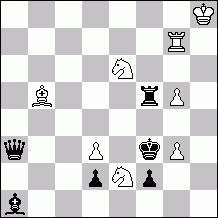 h2# 8+6 B: f5 -> e4 |
A: 1.Kf3-g4 Bb5-d7 2.Rf5-f3 Se6-f4# x = g4 , y = d7 B : 1.Re4-b4 Se6-d4+ 2.Kf3-e3 Rg7-e7# x = e3 , y = e7 |
List of Participants
The director received 105 entries by 44 composers from 21 countries. 38 problems by 9 composers (20 of them by a single composer) were found non-thematic and/or unsound, and were returned to their authors. 9 of these came back as corrected versions. On 2 September 2002, 76 sound problems were submitted (anonymously) to the judge, Menachem Witztum, for evaluation. A number was assigned to each correct entry as follows:
Uri Avner (Israel) 1, 5, 5a, 10, 18; Anatolij Vasilenko (Ukraine) 2; Árpád Molnár (Hungary) 3, 4, 7, 8, 9, 75, 76; Yoel Aloni (Israel) 11; Jean Haymann (Israel) 12, 13, 14; Jozef Lozek (Slovakia) 15, 16 Michael Shapiro (Israel) 17, 29-32, 37, 53, 54, 58; Fadil Abdurahmanović (Bosnia & Herzegovina) 19; Ricardo de Mattos Vieira (Brazil) 20; Johan de Boer (Netherlands) 21; Viktor Syzonenko (Ukraine) 22-24; Mircea M. Manolescu (Romania) 25-28; Michal Dragoun (Czech Republic) 33-35; Michal Dragoun & Dieter Müller (Czech Republic & Germany) 36; Colin Sydenham (England) 38, 74; Leonid Lyubashevsky (Israel) 39; Leonid Lyubashevsky & Leonid Makaronez (Israel) 40; Vito Rallo & Roberto Cassano 41; L. Togookhuu (Mongolia) 42-44; Jozsef Pasztor (Hungary) 45-47; Miomir Nedeljković (Yugoslavia) 48, 49; Mario Parrinello (Italy) 50-52 Raffi Ruppin (Israel) 55; Alexander Semenenko (Germany) 56; Valerij Semenenko (Ukraine) 57; Jorge Humberto Brun (Argentina) 59; Henryk Grudzinski (Poland) 60; Strahinja Mihajlović (Yugoslavia) 61; Borislav Gadjanski (Yugoslavia) 62; Vito Rallo & Roberto Cassano (Italy) 63, 64; Kamlik Karapetyan (Armenia) 65; Manfred Rittirsch (Germany) 66; Ion Murarasu (Romania) 67; Christer Jonsson (Sweden) 68; Franz Pachl (Germany) 69, 70; Franz Pachl & Dieter Müller (Germany) & Helmut Zajic (Austria) 71; V. Gorbunov, V. Shevchenko & V. Melnikov (Ukraine) 72; Amith Sadeh (Israel) 73.
Award
by Menachem Witztum
Dedicated to the memory of my parents Yafa and Shmuel Witztum
A lot of deliberation went into finding a theme for this tourney, preferably an original one that had never been used before.
The theme finally selected is paradoxical: In a H#2, two pieces, black and white, must evacuate a line for a line-piece to arrive at the line for delivering the mate; also, the black King must actively arrive at the line. On first sight, these prerequisites may look irrational and impossible to obtain. The composer's challenge, then, would be to prove otherwise.
I must admit that for a short while I was concerned lest the constraints posed by the theme would deter potential composers, so that I would remain with the prizes. To my great surprise and joy, more than 100 problems by 44 composers arrived (76 of which-thematic), most of them of a very high level. The difficulty, so it seemed, had only motivated many composers to try and cope with the challenge.
There were a number of possibilities to overcome the technical problems inherent in the theme.
To prevent the thematic black piece from interfering with the mate, several mechanismus are possible:
- the black piece enters a white line and is pinned by the black King's move.
- the black piece sacrifices itself.
- the black piece is a pawn.
- the black King moves to interfere with the line of the black piece.
- the white piece interferes with the line of the black piece.
Also, white must guard the square vacated by the black King by using one of several devices:
- a check on the first move.
- a guard by the mating line-piece.
- opening a white line by black.
- a guard by a move of a white piece.
- creation of a white battery where the front piece moves to guard the square.
The possible combinations of these different black and white options had given rise to a wide array of problems (also, in conjunction with additional themes).
The judging process was not easy, reflecting the difficulty to tell between good problems. Surely, many problems not included in the award will do well in other tourneys.
Special thanks go to the devoted director, Emanuel Navon, who did an excellent job every step of the way. Thanks to Zivko Janevski for the originality checking (only 3, very partial, predecessors where found). Further thanks to Michal Dragoun who dedicated 2 interesting problems to me in the Czech magazine (of which one is brought in the annex). They were unfit for the tourney as they utilized a Zeroposition.
My thanks to Uri Avner for translating the Hebrew text into English, and making this publication possible.
Finally, many thanks to all the participants for the great pleasure their problems have given me. A problem composed in collabo-ration with the tourney director, comprising the Schiffmann effect, is dedicated to them (see annex).
I ranked the problems as follows:
|
Fadil Abdurahmanovič
1st Prize  h2# 7+10 |
1.Bb3! Sc4+ 2.Kd4 Rd7#
1.Bg3! Sf5+ 2.Kf4 Qb8# |
|
1st Prize, no. 19, Fadil Abdurahmanović (Bosnia & Herzegovina).
An impressive mechanism. The 1st black move allows the black King a non checking 2nd move, which pins a black piece, while White's 1st move shuts-off a white Rook's line. All this, in an economical setting without twinning. The problem is enjoyable and rich in content. |
|
Michal Dragoun
2nd Prize 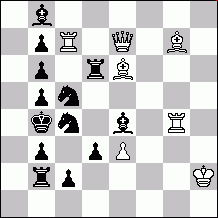 h2# 7+13 B: Rg4 -> c2 |
a)
1.Bd5 Rxc4+ 2.Kxc4 Qh4# b) 1.Rc6 Qxc5+ 2.Kxc5 Bf8# |
|
2nd Prize, no. 33, Michal Dragoun (Czech Republic).
By means of a first-rate technique, the thematic white pieces sacrifice themselves while capturing black pieces, thus letting the black King reach his final destination through grabbing them. The final accord is provided by the mating piece which replaces its sacrificed colleague on the line. An excellent and surprising problem, despite its imperfect twinning mechanism and the somewhat clumsy construction. |
|
Borislav Gadjanski
3rd Prize 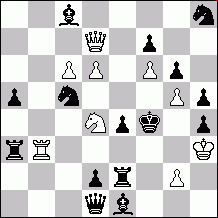 h2# 9+15 B: Sd4 -> e5 |
a)
1.Sd3 Se6+ 2.Ke3! Qa7# 1.Se6? S:e2+/S:e6+ 2.Kf5 Rb5#? 1.Sd3! Se6+ 2.Kf5? Rb5#? b) 1.Se6 Sd3+ 2.Kf5! Rb5# 1.Sd3? S:g6+/S:d3 2.Ke3 Qa7#? 1.Se6! Sd3+ 2.Ke3? Qa7#? |
|
3rd Prize, no. 62, Borislav Gadjanski (Yugoslavia).
An additional colorful element is provided by White's 1st move. Besides guarding the black King's square, it also unpins the appropriate mating piece in each phase. A nice problem, showing a clever mechanism. The composer indicates 2 further tries in each phase showing moves from the other twin. The price for these tries are additional black pieces. However, the tries could be given up, making it possible to replace Re2 with a Pawn and shift the black Queen to d2 |
|
Franz Pachl
4th Prize 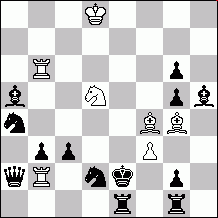 h2# 7+13 B: Sd2 <-> f3 |
a)
1.Kd1 Sc7 2.Sxf3 Rd6# b) 1.Kf2 Bc7 2.Sxd2 Rf6# |
|
4th Prize, no. 69, Franz Pachl (Germany).
In the 2 phases Rb6 is unpinned by the arrival of the Knight and Bishop at c7. This is combined with interesting pinnings of the black Knight. The twinning device concords with the theme. |
|
Mario Parrinello
5th Prize 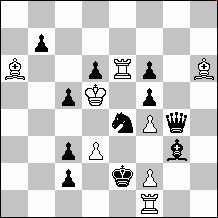 h2# 8+11 B: Se4 <->d3 |
a)
1.Kf3 Bxb7 2.Sxf2 Kxd6# b) 1.Kd2 Rxd6 2.Sxf4+ Kxc5# |
|
5th Prize, no. 50, Mario Parrinello (Italy).
A royal battery combined with different self-pins of the black Knight, producing, due to the twinning device, an impressive problem. |
|
Uri Avner
6th Prize 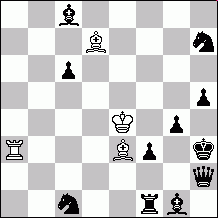 h2# 4+11 B: -wBe3 |
a)
1.Kh4 Ra4 2.g3 Ke5# (2...Kf5??) b) 1.Kg2 Bxc6 2.f2 Kd4# (2...Ke3??) |
|
6th Prize, no. 18, Uri Avner (Israel).
Creation of a royal battery where the white King must choose the correct square to avoid closing the white line just opened by black - the Mari theme. The wBe3 of the 1st twin disturbs a little. A very light setting. |
|
Jean Haymann
1st Honourable Mention  h2# 9+5 |
1.Kd3 Re7 2.S4xf3 Rd8#
1.Kc3 Bf8 2.Sxc6 Qh8# |
|
1st Hon. Mention, no. 13, Jean Haymann (Israel).
A smooth execution, where the mate is given by a line-piece that replaces the line-piece that has left the interval to guard squares next to the black King. |
|
Franz Pachl
2st Honourable Mention 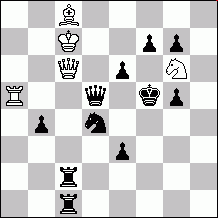 h2# 5+11 B: Qd5 <->e6 |
a)
1. Ke4 Qc4 2. Qb7+ Bxb7# b) 1. Kf6 Qc3 2. Qa6 Rxa6# |
|
2nd Hon. Mention, no. 70, Franz Pachl (Germany).
The white Queen is the white piece that is leaving the interval, whereas the mate is given by another line-piece which captures the sacrificed black Queen. A clever mechanism. The twinning concords with the theme. |
|
Miomir Nedeljkovic
3rd Honourable Mention 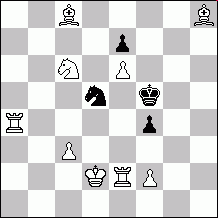 h2# 9+4 B: Sc6 ->c5 |
a)
1.Se3 Sd4+ 2.Ke4 Bb7# b) 1.Sf6 Se4 2.Ke5 Ra5# |
|
3rd Hon. Mention, no. 48, Miomir Nedeljković (Yugoslavia).
A pleasing execution where the black King reaches the squares previously guarded by 2 white pieces. |
|
Franz Pachl, Dieter Müller, Helmut Zajic
4th Honourable Mention 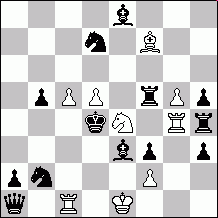 h2# 9+13 B: Ke1 ->f1 |
a)
1.Kd3 Bg6 2.Rf7 Sf6# b) 1.Ke5 Re1 2.Bc1 Sd2# |
|
4th Hon. Mention, no. 71, Franz Pachl, Dieter Müller (Germany) & Helmut Zajic (Austria).
An interesting combination of interferences. There is a self-interference by the parting black piece on the square left by the white piece, while the 2nd white piece interferes with the line of the interfering black piece. |
|
Viktor Syzonenko
5th Honourable Mention 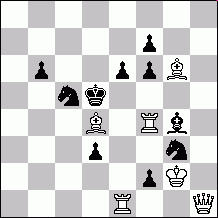 h2# 6+10 B: Bd4 ->c3 |
a)
Be2 Rf5+ 2.Ke4 Qh4# b) Se2 Rd4+ 2.Ke5 Qh2# |
|
5th Hon. Mention, no. 24, Viktor Syzonenko (Ukraine).
In each phase a white Rook interferes with a white Bishop, a black piece is pinned, and a mate is delivered by the white Queen. Interesting. |
|
Uri Avner
6th Honourable Mention 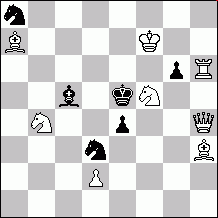 h2# 5+7 |
1.Se2 Qxd5+ 2.Kg4 Ra4#
1.Bc6 Qxf4+ 2.Ke6 Bb3# |
|
6th Hon. Mention, no. 10, Uri Avner (Israel).
The unbelievably free white Queen captures the unemployed black piece in each solution. A nice construction with model mates. |
|
L. Togookhuu
1st Commendation  h2# 4+8 B: Bg7 ->f7 |
a)
1.Be5 Rh4 2.Kd4 Kxf3# b) 1.Sd2 Bh5 2.Ke2 Kxf4# |
|
1st Comm., no. 56, L. Togookhuu (Mon-golia).
A royal battery where the white King captures the corresponding black piece. A light construction, but the twinning by moving a thematic piece is a bit disappointing. |
|
Alexander Semenko
2nd Commendation  h2# 4+12 |
1.g5 Sc5+ 2.Kc6 Rh6#
1.f4 Sd8+ 2.Kc8 Qh3# |
|
2nd Comm., no. 56, Alexander Semenenko (Germany).
The white Knight interferes with a white line in both solutions. A nice and efficient mechanism. |
|
Mircea Manolescu
3rd Commendation 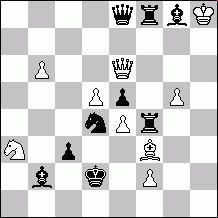 h2# 9+9 |
1.Kc1 Qh6 2.R4f6 gxf6#
1.Kd3 Qd6 2.Se6 dxe6# |
|
3rd Comm., no. 27, Mircea Manolescu (Romania).
A unified mechanism of capturing the black piece by a white Pawn.
|
|
Jean Haymann
4th-8th Commendation e.a. 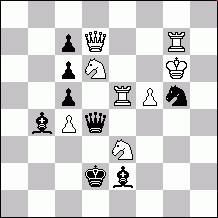 h2# 8+8 B: Se3 ->a1 |
a)
1.Kd3 Sb5 2.Qxd7 Rxd7# b) 1.Kc3 Rd5 2.Qxg7+ Qxg7# |
|
4th-8th Comm., no. 14, Jean Haymann (Israel).
An interesting mechanism, where the white Queen and Rook reciprocally capture the black Queen that captures one of them. See (below) a problem by C.J.Feather, showing a similar representation, not including the reciprocal capturing. |
|
C.J. Feather
Moultings 1992  h2# 6+8 B: Rh3 ->a3 |
To no. 14
a) 1.Kc6 c2xd3 2.Rxc1 Rxc1# b) 1.Ke4 c3 2.Qxb1 Bxb1# |
|
Mircea Manolescu
4th-8th Commendation e.a. 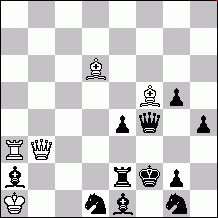 h2# 5+11 |
1.Qf3 Bc5+ 2.Kg3 Qb8#
1.Qe3 Qf7 2.Kf3 Be6# |
|
4th-8th Comm., no. 26, Mircea Manolescu (Romania).
Different moves by the black Queen belonging to 2 thematic lines, bring about different mates by the white Queen, and this - without twinning. |
|
Michal Dragoun
4th-8th Commendation e.a. 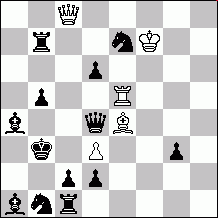 h2# 5+13 B: d3 ->b2 |
a)
1.Qb2 Qh8 2.Kc3 Rxb5# b) 1.Qb4 Qg4 2.Kc4 Bxc2# |
|
4th-8th Comm., no. 34, Michal Dragoun (Czech Republic).
The black Queen takes refuge behind the black King. Cute! |
|
Raffi Ruppin
4th-8th Commendation e.a. 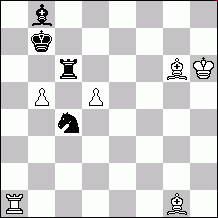 h2# 6+4 |
1.Ra6 d6 2.Ka8 Be4#
1.Sa5 bxc6+ 2.Ka6 Bd3# |
|
4th-8th Comm., no. 55, Raffi Ruppin (Israel).
Indirect and direct unpinning of the white Bishop. A feathery position. The capture of the black Rook impairs a little. |
|
Colin Sydenham
4th-8th Commendation e.a. 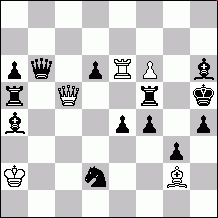 h2# 5+13 B: Rf5 <->g3 |
a)
1.Kg4 Qc8 2.Rb5 Re5# b) 1.Kg5 Qg1 2.Re3 Bf3# |
|
4th-8th Comm., no. 74, Colin Sydenham (England).
The black Rook closes black lines while its own lines are closed by white pieces. This determines the move order. Interesting.
|
|
There are two additional problems I would like to mention, not so much because they are better than other problems not included in the award, but because they show certain elements not tackled by the problems above:
|
|
Arpád Molnár
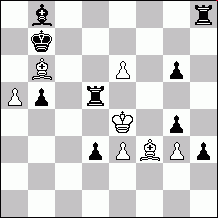 h2# 7+9 B: Ph3 ->c7 |
a)
1.Ka8 Bh1 2.Rd4+ Kxd4# b) 1.Kc6 Bg2 2.Re5+ Kxe5# |
|
No. 4, Árpád Molnár (Hungary).
The black King moves in 2 directions on the thematic line, while the white Bishop has to reach the right square on this line as well.
|
|
Jorge Humberto Brun
 h2# 6+12 B: Rg3 ->c1 |
a)
1.Rxd4+ Rg5 2.Ke5 Qh2# b) 1.Be4 d5 2.Kxd5 Qd1# |
|
No. 59, Jorge Humberto Brun (Argen-tina).
The black pieces pin themselves. the two phases are imbalanced and short of unity.
|
|
Menachem Witztum, Tel Aviv, June 2003
|
|
Annex
|
|
|
Michal Dragoun
Dedicated to Menachem Witztum - 50 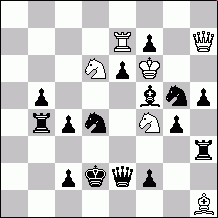 h2# 6+15 Zeroposition a) Sd6 ->b2 b) Sf4 ->d1 |
a)
1.Ke3 Sxe6 2.Sgxe6 Qh6# b) 1.Kd3 Sxf5 2.Sxf5 Rd7# |
|
Menachem Witztum &
Emanuel Navon
Dedicated to the participants of this tourney  h2# 9+8 B: Qd4 ->e4 |
a)
1.Kd6 Sc5 (Sf4?) 2.Qxd2 Rxd2# b) 1.Kf5 Sf4 (Sc5?) 2.Qxc2 Bxc2# |